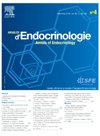内分泌干扰物:减少在医院和家庭中的接触,这是区域卫生局支持的一个项目
IF 2.9
3区 医学
Q3 ENDOCRINOLOGY & METABOLISM
引用次数: 0
摘要
内分泌干扰物(EDs)是一种模拟激素的物质,可以引起各种疾病,孕妇和儿童尤其容易受到影响。我们的机构得到了ARS的资助,在多学科委员会的协调下,培训员工,提高患者意识,减少产科护理中的ED暴露。通过FEES项目(孕妇环境与健康)课程和与专家(流行病学家、毒理学家、专门研究不孕症的内分泌学家)的会议,为医院工作人员和自由医生、助产士提供方法和结果。在内分泌和妇科会诊期间分发患者意识传单;为孕妇和内分泌科患者举办互动式环境卫生教育讲习班;教学柜:陈列避免或偏爱的日常用品的教学柜255名患者(77%为女性,各年龄段)完成了满意度调查。总的来说,85%的患者认为这项倡议很有价值,65%的患者认为能够实施纺织品、室内空气质量、家用产品、食品、食品节约和化妆品方面的建议。主要障碍包括成本、时间限制和习惯。创建二维码,对妊娠期糖尿病孕妇进行教育,并开展ED暴露多中心流行病学研究(目前385例)。另制作二维码,重点关注与ed相关的内分泌及妇科疾病(PCOS、子宫内膜异位症、甲状腺炎等),目前有25例患者。对工厂使用的产品进行外部审计和诊断,以确定污染源,并从“生境-桑塔姆-环境”获得“健康产妇”标签。我们分析了350份技术数据表、安全数据表和药品特性(家用产品、化妆品、医疗器械、食品、建筑材料)。改进措施包括:使用生态标签的洗涤剂,去除喷雾式空气清新剂,停止使用Spasfon片剂(含有二氧化钛)。药物对健康的有害影响有充分的证据。我们有责任在医疗机构内提高护理人员和患者的认识。本文章由计算机程序翻译,如有差异,请以英文原文为准。
Endocrine disruptors (EDs): Reducing exposure in hospitals and homes, a project supported by the Regional Health Agency (ARS)
Introduction
Endocrine disruptors (EDs), that mimic hormones, can cause various pathologies, with pregnant women and children being particularly vulnerable. Our institution received funding from the ARS to train staff, raise patient awareness, and reduce ED exposure in maternity care, coordinated by a multidisciplinary committee.
Methods and results
Training for hospital staff and liberal doctors, midwives, through FEES project (Pregnant Women Environment and Health) courses and conferences with experts (epidemiologists, toxicologists, endocrinologist specializing in infertility).
Patient awareness flyers distributed during endocrinology and gynecology consultations; interactive environmental health education workshops for pregnant women and patients in endocrinology; a teaching cabinet displaying everyday items to avoid or favor.
A satisfaction survey was completed by 255 patients (77% women, all ages). In all, 85% of patients find the initiative valuable, and 65% feel able to implement advice on textiles, indoor air quality, household products, food, food conservation, and cosmetics. Key barriers included cost, time constraints, and habits.
A QR code was created to educate pregnant women with gestational diabetes and conduct a multicentric epidemiological study on ED exposure (385 patients for now). Another QR code was elaborated, focused on endocrinological and gynecological conditions related to EDs (PCOS, endometriosis, thyroiditis, etc.) with 25 patients for now.
External audit of practices and diagnostic of products used in the facility, to identify pollution sources, and obtain the “Healthy Maternity” label from “Habitat-Santé-Environnement”. We analyzed 350 technical datasheets, safety data sheets, and drug characteristics (household products, cosmetics, medical devices, food, building materials). Improvements included for example: using eco-labeled detergents, removing spray air fresheners, and discontinuing Spasfon tablets (containing titanium dioxide).
Discussion
EDs have well-documented harmful effects on health. It is our duty to raise awareness among both caregivers and patients within healthcare institutions.
求助全文
通过发布文献求助,成功后即可免费获取论文全文。
去求助
来源期刊

Annales d'endocrinologie
医学-内分泌学与代谢
CiteScore
4.40
自引率
6.50%
发文量
311
审稿时长
50 days
期刊介绍:
The Annales d''Endocrinologie, mouthpiece of the French Society of Endocrinology (SFE), publishes reviews, articles and case reports coming from clinical, therapeutic and fundamental research in endocrinology and metabolic diseases. Every year, it carries a position paper by a work-group of French-language endocrinologists, on an endocrine pathology chosen by the Society''s Scientific Committee. The journal is also the organ of the Society''s annual Congress, publishing a summary of the symposia, presentations and posters. "Les Must de l''Endocrinologie" is a special booklet brought out for the Congress, with summary articles that are always very well received. And finally, we publish the high-level instructional courses delivered during the Henri-Pierre Klotz International Endocrinology Days. The Annales is a window on the world, keeping alert clinicians up to date on what is going on in diagnosis and treatment in all the areas of our specialty.
 求助内容:
求助内容: 应助结果提醒方式:
应助结果提醒方式:


